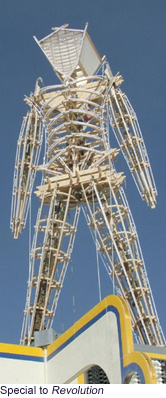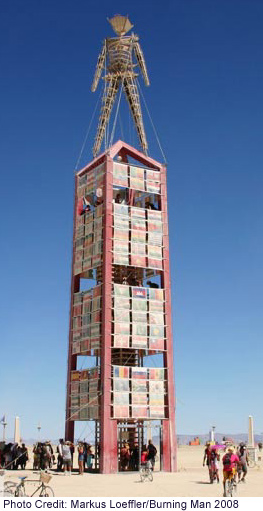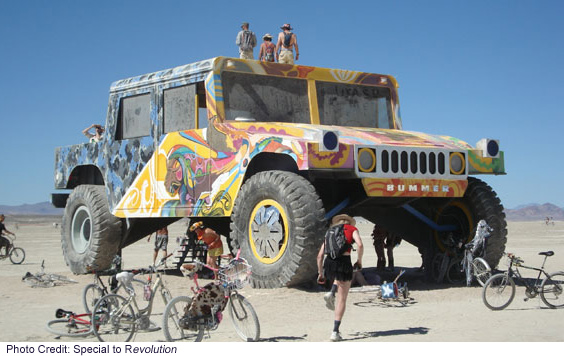Revolution Online, September 23, 2008
Correspondence:
“Burning Man” 2008: The Myth and Reality of the “American Dream”
Every year, high in the Nevada desert, a city of 50,000 inhabitants is created – and then disappears – within 8 days.
 This is Black Rock City, the home of Burning Man, an annual celebration of art and community that brings participants from all over the world to an inhospitable, ancient lakebed. While most of the year Black Rock desert is unpopulated and desolate – no trees, no grass, no water nor visible life – during Burning Man it blossoms with culture, flame, music, and neon lights as a mega-block party in the week before Labor Day, in the face of white-out windstorms and unbearable heat (or rain and cold). From its beginning in the ’80s on a San Francisco beach, the conception of the original founders was, "Let's build a statue and burn it." Every year since, the event crescendos toward the ritual burning of the 30-foot wooden "Burning Man."
This is Black Rock City, the home of Burning Man, an annual celebration of art and community that brings participants from all over the world to an inhospitable, ancient lakebed. While most of the year Black Rock desert is unpopulated and desolate – no trees, no grass, no water nor visible life – during Burning Man it blossoms with culture, flame, music, and neon lights as a mega-block party in the week before Labor Day, in the face of white-out windstorms and unbearable heat (or rain and cold). From its beginning in the ’80s on a San Francisco beach, the conception of the original founders was, "Let's build a statue and burn it." Every year since, the event crescendos toward the ritual burning of the 30-foot wooden "Burning Man."
Since 1990, Burning Man has become an experiment in creating a culture that eschews money and disdains commodification. Though tickets are sold for the event, it is mainly to cover the stiff price demanded by the U.S. government for the use of the land and the required payment for invasive, and gawking, law enforcement. But unlike other events, once inside, there is nothing for sale – except ice and coffee in the center cafe. It is a gift economy, in which people are encouraged to bring what they need and share with others, to embrace diversity and be participants, not spectators.
And art! Hundreds of art placements that break convention in collective collaboration and in sheer size, interactivity and irreverence, and prompt new ways to look at the familiar. Art that is not considered the sole province of trained artists.
Every year, Burning Man founder Larry Harvey establishes the art theme for the event – such as "The Future, Hope and Fear," “The Psyche,” "Beyond Belief," or "The Vault of Heaven" – which is the core idea around which participants can revolve, interpreting and tripping out, often in very surprising artistic and philosophical directions.
Though a non-typical slice of society, people who attend Burning Man are also affected by the larger dynamics and working of this system and the direction it is headed. In the last few years, particularly since 9/11 with the launching of the “war on terror” and the growing police state mentality, many (myself included) have noticed that while the radical edge of Burning Man has not vanished, it has been somewhat constrained within the societal “new normal” and “what is possible.” This year, developments such as the elections, the "end" of the Bush regime, and the Obama campaign with its promises of “change” were also having a big effect.
When this year's art theme, "American Dream," was announced, it was like, "What the Fuck?! Where did this come from?" I think the conception behind the theme was of a never-was-and-never-will-be "pure" democracy as the highest ideal to which we can aspire. As I understand it, they hate the outrages and excesses of this government trampling on the rights of the individual, but are caught up in so-called progressive patriotism.
 Immediately opposition mounted. An online petition campaign called on the organizers to choose a new theme. But the theme remained, with the narrative modified somewhat to be less openly celebratory, patriotic, and uncritical, and more a view of America as a lumbering giant with a blotched history, not living up to its promise of democracy and world leadership. The design of "the Man" would include the flags of all nations.
Immediately opposition mounted. An online petition campaign called on the organizers to choose a new theme. But the theme remained, with the narrative modified somewhat to be less openly celebratory, patriotic, and uncritical, and more a view of America as a lumbering giant with a blotched history, not living up to its promise of democracy and world leadership. The design of "the Man" would include the flags of all nations.
While there was much sentiment against the ugliness of the Bush regime, there was also an attempt to unite around and accentuate the supposed inherent good in the U.S. and its people, without looking at how America is rooted in slavery of Black people and genocide against Native peoples, and how today the U.S. sits at the top of an international system of exploitation where over a billion people live on less than $2 a day, backed by a huge military, wars, and invasions.
Some of those who originally objected to the theme later argued that it would challenge artists to present their own views on America, and promote deeper thinking and art that represented oppositional thought. Though I was, frankly, skeptical at that notion, that turned out to be true.
****
On the long drive from the highway onto the desert city, there was a series of “Burma-Shave” signs with famous (and not so famous) quotes about democracy and the "American Dream" – mostly well within a bourgeois democratic framework. The first one was by far the best – a quote from recently departed comedian George Carlin: "It's called the American Dream because you have to be asleep to believe it!"
It is humanly possible to visit only a small percentage of the approximately 200 art installations (not to mention all of the camps) spread about the huge city in a few days – even by bicycle. I obviously missed a lot in this constantly changing landscape.
I didn’t see any installations that unabashedly celebrated America, though there were a few that encouraged people to vote, write their representatives, or meditate for peace. There were others encouraging “dreaming your own dream.”
 There were many truly incredible pieces, both large and small, that were beautiful and awe inspiring. Among them were: the Basura Sagrada, a massive temple built of burnable trash, recycled materials, and the tossed-off debris of American society; the “Bummer,” an oversized 4X4 parody of America’s “King of the Road” mentality; Spread Eagle, 30-foot wide kinetic wings built of steel, redwood and found objects; and Altered State, by NY artist Kate Raudenbush, an exquisite U.S. Capitol fabricated of carved white steel in the graphic styles of America’s Native peoples, in their remembrance and honor.
There were many truly incredible pieces, both large and small, that were beautiful and awe inspiring. Among them were: the Basura Sagrada, a massive temple built of burnable trash, recycled materials, and the tossed-off debris of American society; the “Bummer,” an oversized 4X4 parody of America’s “King of the Road” mentality; Spread Eagle, 30-foot wide kinetic wings built of steel, redwood and found objects; and Altered State, by NY artist Kate Raudenbush, an exquisite U.S. Capitol fabricated of carved white steel in the graphic styles of America’s Native peoples, in their remembrance and honor.
There were other significant pieces that directly confronted the "American Dream.” Here are some highlights:
A group from the Netherlands did a very impressive and intimidating detention prison with a flowery, paisley, almost comical façade of skull and crossbones. But once inside the Checkpoint Dreamyourtopia, captive behind high grey walls, concertina wire and guard towers, “detainees” were forced to fill out lengthy forms completely before proceeding to an interrogation room. A very sobering and visceral experience – you can see a video of this, along with a description by the creator, at http://current.com/items/89252184_checkpoint_dreamyourtopia#comments.
 Another piece of art included a figure of the hooded Abu Ghraib detainee with electrical wires hanging from him, with a sign telling people to pedal a bicycle-powered generator to "zap the prisoner." This was accompanied by photos of U.S. torture and gruesome killings of Iraqis by American troops, and the message "Your tax dollars tortured innocent Iraqi citizens. Something is deeply wrong in America. Why are we not revolting? It is up to us to fix America."
Another piece of art included a figure of the hooded Abu Ghraib detainee with electrical wires hanging from him, with a sign telling people to pedal a bicycle-powered generator to "zap the prisoner." This was accompanied by photos of U.S. torture and gruesome killings of Iraqis by American troops, and the message "Your tax dollars tortured innocent Iraqi citizens. Something is deeply wrong in America. Why are we not revolting? It is up to us to fix America."
There were a number of other artists who, from different angles, spoke against the wars that the U.S. is waging "to bring democracy." One was a schoolhouse, the floor littered with children's toys and dolls, riddled with bullet holes. There was another – a half buried bomb – labeled "got democracy?"
 Some art addressed the attacks on immigrants. One very well done 15-foot-tall milk carton with a "child missing" panel spoke to the murders of 450 young Mexican women workers and the disappearance of 400 more along the Northern Mexico/Texas border, pointing to the role of NAFTA and the vicious sweatshops that produce products for the U.S.
Some art addressed the attacks on immigrants. One very well done 15-foot-tall milk carton with a "child missing" panel spoke to the murders of 450 young Mexican women workers and the disappearance of 400 more along the Northern Mexico/Texas border, pointing to the role of NAFTA and the vicious sweatshops that produce products for the U.S.
Another was a bridge to Ellis Island – as you cross it, you pass signs asking questions about your medical, political, criminal and legal status.
One artist displayed a large cargo net – the kind used to capture animals, or slaves – upon which were written the famous words on the Statue of Liberty, "Give me your tired, your poor, your huddled masses, yearning to be free."
There were hundreds of American flags flown upside-down throughout the camps, along with many "earth" flags. I was told that there were many Iraqi vets and active-duty soldiers in attendance. There was not a strong "support our troops" presence, though one camp I saw had a large board upon which people could write messages “thanking” the troops. It was sparsely filled at the end of the week, and many of the messages were distinctly anti-war.
And throughout the week, a “guerrilla” group distributed perhaps thousands of small inverted American flags with the Burning Man logo and the words "Burn the American Dream.”
****
There is much to embrace about Burning Man. Since its beginning it has been a radical, counter-cultural gathering. Those promoting traditional values and fundamentalist beliefs would feel uncomfortable in these blasphemous surroundings, where sacred cows are ridiculed, and space is carved out for people to be free to think, and act, outside of proscribed politics, religion, sexuality and ideology.
At the same time it runs up against the limits imposed by the dominant productive and social relations in society, and the ideas promoted to enforce those relations. The ideology that people bring with them – and to which they will return – constrains their ability to dream in a truly liberating way.
There is a great need for people who are yearning for a different, better world to be introduced to Bob Avakian and his revolutionary vision of the most radical rupture with traditional property relations and traditional ideas, and a vibrant, exciting communist world in which people would really thrive – the unleashing of art and science, awe and wonder, ferment and imagination in mind-boggling dimensions. Trying to contribute to that, I distributed issues of Revolution newspaper and "gifted" people I met with Bob Avakian's "7 Talks," a "Burning Man special edition" pamphlet of Avakian's essay "Materialism and Romanticism, Can We Do Without Myth?" and the new RCP Constitution.
One of the most exciting things I experienced was a discussion with two professors from England, an award-winning filmmaker, a Burning Man medic doing graduate work in sociology, and a couple of anti-war activists. We got into the nature and history of democracy in the U.S., art, freedom, and philosophy. They were very intrigued with what I brought to the conversation, and very interested in learning more about the RCP and Bob Avakian's work. They found particularly refreshing Avakian’s epistemological point about how all truths are good for the proletariat, and everything that’s actually true can help us get to communism – even truth that "makes us cringe” or that are discovered by people that oppose us – as compared to the method of "political truth" that has often characterized much of the revolutionary, even communist, movement. They were also quite surprised at Avakian’s embrace of art, science and human cultural endeavors broadly, and his statement that “If you don’t have a poetic spirit – or at least a poetic side – it is very dangerous for you to lead a Marxist movement or be the leader of a socialist state.”
The medic, whom I had talked to a couple of years ago, interjected that even though he has certain opposition to Avakian (and my continuing promotion of him), he does think that Avakian has the most provocative and broadly insightful things to say compared to any other revolutionary leader, and that people should pay attention to him.
We all agreed upon the need for more of these wide-ranging conversations at Burning Man, and inviting more people into the discussion. There was some initial talk about making plans for next year to call on the many academics, artists, scientists and thinking people who come to Burning Man to gather together and engage in lively discussions of art and culture, science and philosophy, with the aim of understanding the world in all its textures in order to transform it. Next year's theme, Evolution (celebrating the 200th anniversary of Charles Darwin’s birth), will be perfect for this.
If you like this article, subscribe, donate to and sustain Revolution newspaper.



